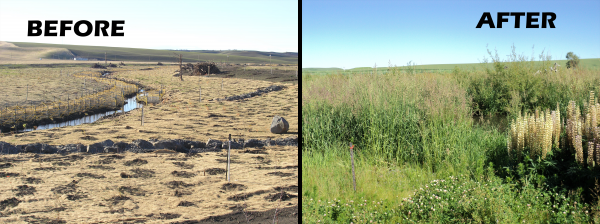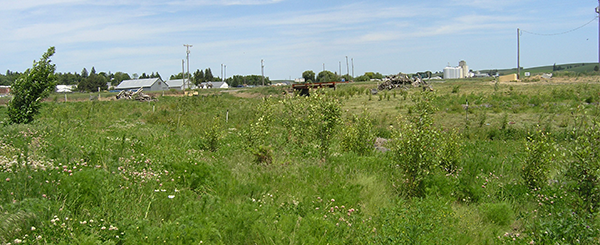What was once a wind-blown wheat field near the small Idaho town of Genesee is now an environmental success story. A dozen years later, ITD has created a thriving, marshy wetlands area where one never existed before.
Genesee, a town of fewer than 1,000 folks, is a quiet community resting in the rolling hills and prairie that dominate Idaho’s Palouse country, midway between Moscow and Lewiston. When road construction on U.S. 95 in the spring of 2005 from the top of Lewiston Hill to Genesee required using some land designated as wetlands, ITD spearheaded a mitigation project to construct wetlands as compensation.
The project became known as “Cow Creek Wetland,” located along a half-mile of Cow Creek in Latah County next to Genesee between two county roads — Morscheck and Kreier
ITD eventually created almost 11.5 acres of wetland and riparian area to mitigate for area impacted by the highway project, at a cost of $1.5 million.
Construction started in 2005, as there were wells drilled at each corner of the area to provide water for the irrigation system and help plants get established. Excavation, irrigation system and initial plantings were completed that year. Nearly 24,000 containerized trees and shrubs were part of the mitigation plan. In addition, there were almost 35,000 plugs of wetland grasses, rushes, sedges, and more planted in 2005.

Then came the winter of 2005/2006, when roughly 90 percent of those wetland plugs were lost due to frost heaves. So, planners returned to the drawing board.
Spring of 2006, wetland areas were broadcast-seeded to compensate for the loss that first winter. In addition to seeding and planting, trees removed during the project were placed in the wetland as habitat snags, and in November of 2007 an additional 2,500 containerized plants were planted as warranty to replace trees and shrubs that had died.
The irrigation system, installed to provide watering as the vegetation got established, was turned off in 2008 to encourage plants to acclimate to their natural conditions.
By August of 2010, the U.S. Army Corps of Engineers stamped the site as completed.Many Genesee residents, who also use it for bird watching, today use the Cow Creek Wetland as a walking trail.
Most impressively, it is used as a wetland ecology classroom by the local high school.

